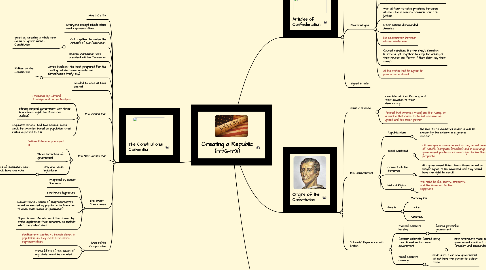
1. Articles of Confederation
1.1. Benefits
1.1.1. Gave power to the states
1.1.2. Survey Act of 1785
1.1.3. Northwest Ordinance Act of 1787
1.2. Disadvantages
1.2.1. The federal government could only actually do a few things
1.2.2. taxes / other important matters that should be with the central government, were left to the states
1.2.3. was difficult to solve problems between states - there was no common court of justice
1.2.4. Other nations disregarded America
1.2.5. No coordination between states whatsoever
1.2.6. Caused rebellions like the Shay's Rebellion (farmers got together to stop the seizing of their houses and farms if they didn't pay their taxes)
1.2.7. all the states had to agree to pass an amendment
1.3. Signed in 1783
2. The Constitutional Convention
2.1. May 25, 1787
2.2. Everyone except Rhode Island sent representatives
2.3. Got together to revise the Articles of Confederation
2.3.1. ended up creating a whole new form of government : Constitution
2.4. George Washington was president of the Convention
2.5. James Madison : the best prepared for the meeting ; studied governments and democracies. (very shy)
2.5.1. Father of the Constitution
2.6. decided to keep all talks secret
2.7. The Virginia Plan
2.7.1. Proposed by Edmund Randolph and James Madison
2.7.2. Strong national government with three branches (Legislative, Executive, Judicial)
2.7.3. Legislative Branch had two houses, seats would be awarded based on population, small states objected to this
2.8. The New Jersey Plan
2.8.1. William Paterson proposed it
2.8.2. Three branches of government
2.8.3. Only one house legislature
2.8.3.1. regardless of population, each state would have one vote
2.9. The Great Compromise
2.9.1. Proposed by Roger Sherman
2.9.2. Two house legislature
2.9.3. Lower house : House of Representatives, would be elected by popular vote (awarded to each state based on population)
2.9.4. Upper house : Senate, would be chosen by state legislatures (two senators, no matter what the states' size)
2.10. Three-Fifths Compromise
2.10.1. Southerners wanted to include slaves in population, so they could have more representatives
2.10.2. Three-fifths of the slaves of any state would be counted
3. Origins of the Constitution
3.1. Rome / Greece
3.1.1. colonists admired Romans, and their devotion to their democracy
3.1.2. feared that America would end like Rome, as a empire that came to its fall because of greed and too much power
3.2. The Enlightenment
3.2.1. Republicanism
3.2.1.1. the idea that a country's leader should be chosen by the citizens in a general election
3.2.2. social contract
3.2.2.1. citizens give up some freedom they would have in a state of nature (complete freedom) and in exchange the government protects citizens' right to life, liberty, and property
3.2.3. Consent of the Governed
3.2.3.1. If a government failed, then citizens would no longer agree to be governed and they would have the right to revolt
3.2.4. Natural Rights
3.2.4.1. the right to life, liberty, property, and the freedom to find happiness
3.2.5. People
3.2.5.1. Montesquieu
3.2.5.2. Locke
3.2.5.3. Rousseau
3.3. Colonists' Experience with Britain
3.3.1. treated colonists harshly
3.3.1.1. feared powerful government
3.3.2. former colonists feared losing their freedom to a new government
3.3.2.1. new Americans made sure their new government could not take away states' freedom and independence
3.3.3. taxed colonists unfairly
3.3.3.1. made sure their new government did not have the power to collect taxes
4. The Constitution
4.1. Federalists: supported the constitution
4.2. Antifederalists: didn't support the Constitution
4.2.1. demanded a bill of rights

